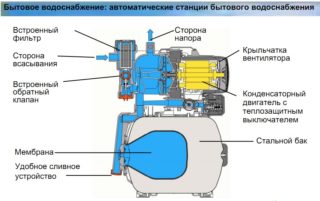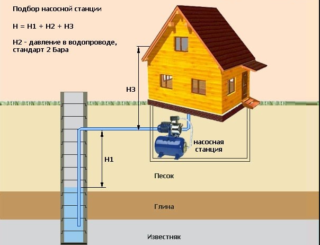Providing water to a private house is one of the very first problems that residents are trying to solve. Without a well and a pump, you cannot connect a washing machine or a dishwasher, or take a shower without additional preparations. Pumping equipment in the country will not interfere, since in the summer you have to water the site every day. What to give preference, a mobile pumping station or a stationary device, is up to the owner to decide. To do this, you need to understand the principles of operation and features of the equipment.
Definition and purpose of a water supply pumping station
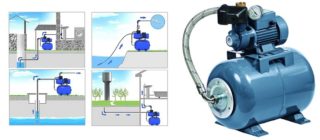
A properly equipped well or well is a big plus for a country house or summer cottage. It is even better if pipes are connected to the source and a pump is installed that delivers water directly to the house. This saves time and effort, and also makes people's lives more comfortable.
Most private home owners prefer pumping stations. This equipment can be assembled with your own hands if you have technical skills - the pumping station diagram is quite simple. However, it is better to buy a ready-made device with factory settings and thoroughly tested before shipping to the buyer.
The pumping station works in automatic mode, so there is no need to constantly monitor switching on and off. The whole process is controlled by the automation unit. The system provides constant pressure, thanks to which any household appliances can be connected. The pressure drops are weak, so the equipment works stably. Water can come from any source - a well, a well, a river, as well as a central water supply system, if there is one nearby.
Advantages of the pumping station:
- A correctly selected unit is able to provide water to a house, utility rooms and a vegetable garden. The main condition is constant voltage in the network and the productivity of the well, which allows pumping out the amount of fluid that is necessary for the needs of the territory.
- Energy saving. The unit turns off automatically when a certain pressure is reached.
- The presence of a hydraulic accumulator, which allows you to make a supply of water in case of a power outage or under other circumstances.
- Surface devices can pump water from the narrowest well thanks to the suction pipe.
- Factory settings rarely require correction, and installation is done in the shortest possible time. This can be done by a person without experience.
- With proper connection and proper operating conditions, the device works for a long time without requiring repair.
Disadvantages of the pumping station:
- High noise level. You need to find a warm place away from living quarters, but such that you can hear a little the sound of a running motor in case of a breakdown.
- The limited depth of the well - the arrangement of water supply pumping stations does not allow reaching water deeper than 9 meters without an ejector.
- If installed permanently, it will not be possible to take the device into the house for the winter, so the location of the station must be well thought out in advance.
- Quite high cost.
The price of the device is due to expensive materials that serve for a long time and do not require frequent repair or replacement of parts.It is not recommended to buy pumps, the mechanical parts of which are made of plastic, since under the influence of solid fractions - sand or stones - the impeller quickly wears out and breaks down.
Equipment device
- with vortex pump;
- with centrifugal pump.
With the same performance, only the method of lifting the liquid from the depth differs. For a private house, medium or low power equipment is sufficient, depending on the number of residents and equipment.
There are also ejector devices that allow you to pump water from a depth of more than 10 meters. These tools are more expensive, but if the well is deep and the water is far away, it is more profitable to buy the right equipment than to drill a new well.
According to the method of accumulating liquid, there are two types of stations - an outdated model with a storage tank and a new model with a hydraulic accumulator.
The storage tank is rarely found on the market, since pumping stations require special installation and maintenance conditions. From the tank, water flows into the pipes by gravity, so the pressure in the tap is small, there is no way to fully use the shower or install, for example, a jacuzzi bath. The storage tank must be installed higher than the pump itself - it is not always possible to find a place for a bulky design of 200-300 liters. In addition, if the filling control sensor breaks down, the room may be flooded.
The accumulator is a small container with a rubber membrane inside. There is air around it. As the pear is filled, the air is gradually compressed and pushes the liquid into the pipes. The device is equipped with a pressure switch, according to the indications of which the station turns on and off.
In addition to storage tanks, pumping stations are equipped with:
- electrical unit - cable, connector, grounding clamps;
- control unit - pressure gauge, pressure switch;
- one of the types of pumps.
The ejector - remote or built-in - is a separate equipment that you can make yourself or buy a ready-made pumping station with additional functions - a pressure head and a recirculation pipe.
Household models and principle of operation
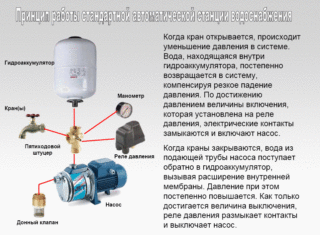
- When the equipment is turned on, the impeller lifts the liquid towards the outlet.
- The water rises along the suction line and fills the rubber membrane. Pressure is created inside, which pushes the liquid into the outlet. The membrane remains full until the engine is turned off.
- Pressure control is carried out using a relay with certain settings. You can visually assess the pressure using a pressure gauge. The station turns on when the membrane is empty, that is, the pressure is minimal and someone opens the tap in the house. After reaching the upper pressure, the device switches off.
In addition to the main functions, the system is equipped with elements of protection against overheating, dry running, as well as filters against the ingress of solid fractions into the inner part of the pump.
There are two types of pumping stations - industrial and domestic. Industrial ones work with large volumes of liquids, so the load on the system is great. Uninterrupted pumping is achieved thanks to the availability of redundant equipment and additional cooling devices.
Domestic pumping stations are of a simpler type. By type of pump there are:
- self-priming;
- multistage;
- vortex;
- centrifugal;
- sewer.
The advantage of a self-priming pump is that it is able to work with air in the system, although for some types this is a problem and the device turns off by itself. During operation, they make a lot of noise, so they are installed in a pit or in a separate isolated room. Water is taken from a depth of up to 9 meters.
Multistage stations are chosen when high performance is required.They are less noisy, but more expensive. The more steps, the more expensive the construction. Capable of lifting liquid from 8 - 9 meters.
A pumping station with a vortex pump works no deeper than 7 meters, but creates a strong head. If the water source is far from the house, such a device is suitable for installation.
Centrifugal pumps are capable of working at great depths and with liquids at different temperatures.
Sewer stations are installed in those places where it is impossible to perform a gravity system. This is a heavy piece of equipment with a variety of sensors and multiple pumps included.
There are also automatic pumping stations that do not have a diaphragm tank. These are compact devices designed for temporary use, for example, for watering a vegetable garden or filling a container with river water for use in the country.
Criterias of choice
- power - there are models from 500 to 2000 W;
- productivity depends on power - the higher it is, the more water the station can pump out per unit of time; for a private house, you need to buy a device with a capacity of about 2000 l / h;
- the volume of the accumulator - can be from 15 to 60 liters; the larger the capacity, the less often the pump will turn on;
- the presence of protection against dry running and overheating - such functions sometimes save devices from combustion;
- the materials for the manufacture of the body and internal parts are cast iron, steel or plastic, in more expensive models the body and the impeller are steel.
If it is necessary to place the device close to living quarters, since there are no other options, it is recommended to choose a cast iron case - it dampens sound better than a stainless steel case, although outwardly steel products look more attractive. The inside of the cast iron is covered with a protective layer against corrosion. The material is less susceptible to vibrations, therefore it lasts longer than technoplastic. In addition, he is not afraid of mechanical damage.
If the well is Abyssinian, an ejector is needed, otherwise a simple, even very powerful station will not raise the water. It must be additionally protected from contamination by installing a filter at the end of the pipe, otherwise it will become clogged with dirt and the pump will stop working.
Installation and connection features
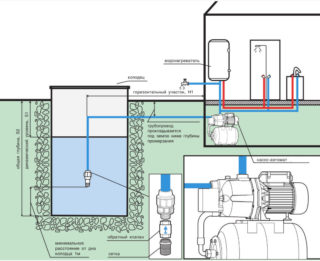
Before starting the installation, choose a place where the pumping station will be permanently located. Most often this is a basement, a warm shed or a pit near a well. In any case, the installation platform must be solid and level. It is best to make a concrete cushion for this at some elevation. In case of flooding of the room, the pump will be safe.
The concrete slab and the device itself should not come into contact with the walls of the house, since vibrations occur during operation - this leads to the destruction of the supporting structures and collapse.
The room must be heated. Condensation can accelerate the appearance of rust on the metal, and the warm air dries out the liquid droplets and maintains its integrity.
If a special depression in the ground - a caisson - is built for the pumping station, it is made below the level of freezing of the soil - about 2 m.The pit is dug with the expectation that people will work in it if the device has to be repaired, so it is not recommended to make it close.
If the room for the station is located within the house, and the equipment is very noisy, the walls should be insulated with special material.
It is not advisable to install electrical equipment on a special site inside the well. Water can rise high and flood the device, which will then not work. In addition, it is difficult to repair something inside the well. The vibrations generated by the surface pumping station gradually destroy the concrete walls and the joints between the rings. The well will fail faster.
Before embedding pipes in the ground, you need to test the entire system for several days. If problems are found, it will be easier to find them.
The cost of pumping stations
Imported counterparts are more expensive - the prices for pumping stations of German, Italian and Japanese manufacturers are the highest. This is due to the use of quality materials for the manufacture of the body and internal parts. Among the imported models, you can find almost silent units.
High-quality products of domestic brands are also worthy of attention. If you choose expensive pumps from Russian manufacturers, you can count on a long service life and timely repair in service centers.

